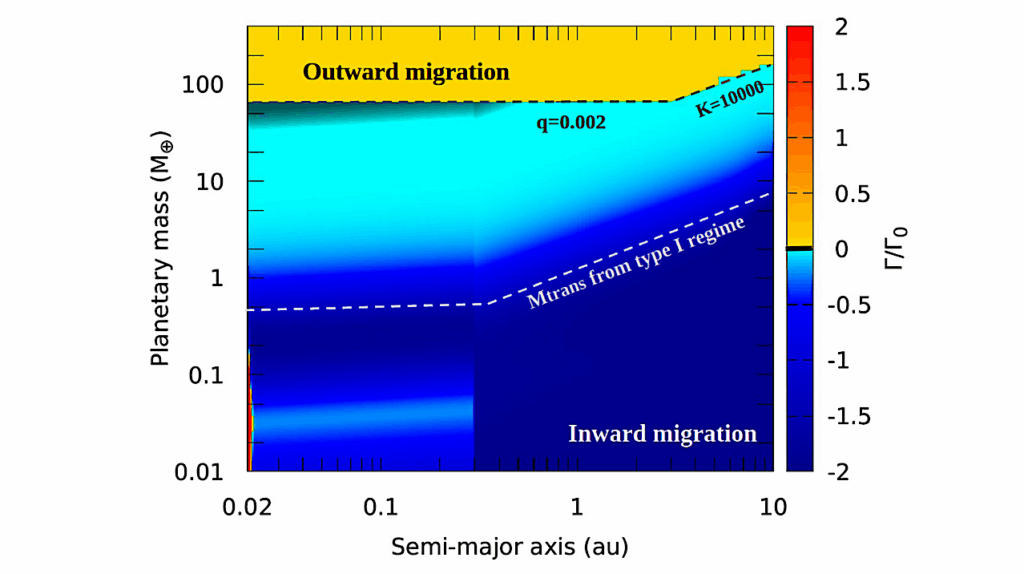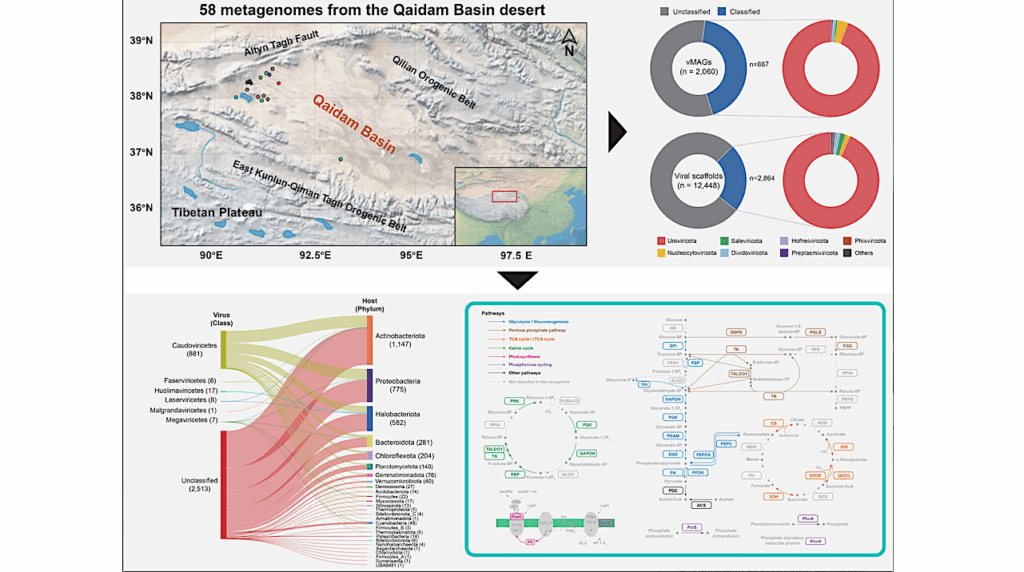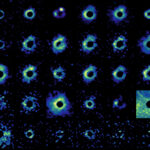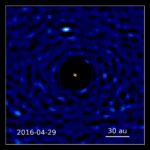Now Reading: Burned To Ashes: How the Thermal Decomposition of Refractory Organics in the Inner Protoplanetary Disc Impacts the Gas-phase C/O Ratio
-
01
Burned To Ashes: How the Thermal Decomposition of Refractory Organics in the Inner Protoplanetary Disc Impacts the Gas-phase C/O Ratio
Burned To Ashes: How the Thermal Decomposition of Refractory Organics in the Inner Protoplanetary Disc Impacts the Gas-phase C/O Ratio
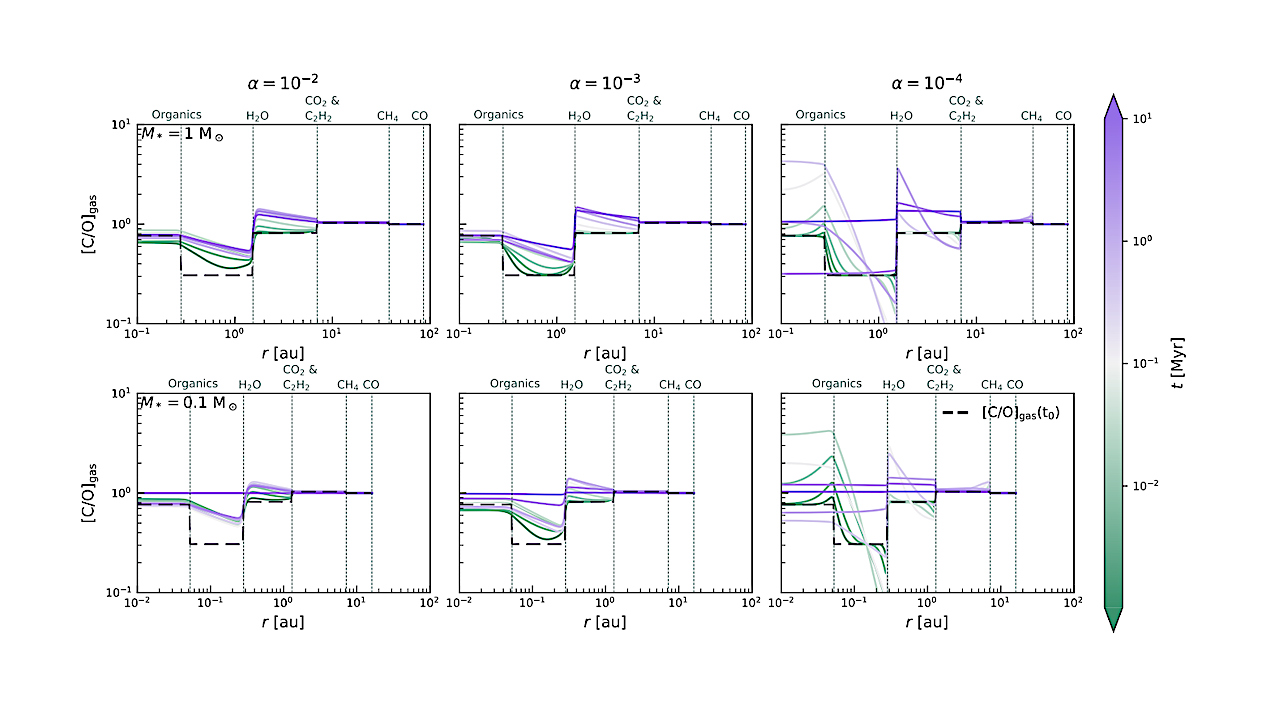

Gas-phase C/O ratio as a function of distance to the star for the two different values of the stellar mass (M∗ = 1, 0.1 M⊙) and three values of the turbulent viscosity (α = 10−2 , 10−3 , 10−4 ). The horizontal dashed grey line represents the initial C/O ratio. The sublimation lines of the main species contributing to the C/O ratio are indicated with vertical lines. We see that the evolution of the gas-phase C/O ratio does not change significantly with varying disc turbulence (α > 10−3 ) and stellar mass. However, in the α = 10−4 case, where the pebble flux is intense and diffusion is slow, the variations in gas-phase C/O ratio are greater. Once the pebble flux runs out, viscous flows govern the evolution of the gas-phase C/O ratio, leading to differences depending on stellar mass. — astro-ph.EP
The largest reservoir of carbon in protoplanetary discs is stored in refractory organics, which thermally decompose into the gas-phase at the organics line, well interior to the water iceline.
Because this region is so close to the host star, it is often assumed that the released gaseous material is rapidly accreted and plays little role in the evolution of the disc composition.
However, laboratory experiments show that the thermal decomposition process is irreversible, breaking macromolecular refractory organics into simpler, volatile carbon-bearing compounds. As a result, unlike the iceline of other volatiles, which traps vapor inwards due to recondensation, the organics line remains permeable, allowing gaseous carbon to diffuse outward without returning to the solid phase.
In this paper, we investigate how this process affects the disc composition, particularly the gas-phase C/H and C/O ratios, by incorporating it into a 1D evolution model for gas and solids, and assuming refractory organics dominantly decompose into C2H2. Our results show that this process allows this carbon-rich gas to survive well beyond the organics line (out to 7 au around a solar-mass star) and for much longer timescales, such that its abundance is increased by an order of magnitude.
This has several implications in planet formation, notably by altering how the composition of solids and gas relate, and the fraction of heavy elements available to giant planets. In the framework of our model, refractory organics significantly influence the evolution of the gas-phase C/O ratio, which may help interpreting measurements made with Spitzer and JWST.
Adrien Houge, Anders Johansen, Edwin Bergin, Fred J. Ciesla, Bertram Bitsch, Michiel Lambrechts, Thomas Henning, Giulia Perotti
Comments: Accepted for publication in A&A. 18 pages, 14 figures, 1 table
Subjects: Earth and Planetary Astrophysics (astro-ph.EP)
Cite as: arXiv:2505.20427 [astro-ph.EP] (or arXiv:2505.20427v1 [astro-ph.EP] for this version)
https://doi.org/10.48550/arXiv.2505.20427
Focus to learn more
Submission history
From: Adrien Houge
[v1] Mon, 26 May 2025 18:24:52 UTC (848 KB)
https://arxiv.org/abs/2505.20427
Astrobiology,
Stay Informed With the Latest & Most Important News
Previous Post
Next Post
-
 012024 in Review: Highlights from NASA in Silicon Valley
012024 in Review: Highlights from NASA in Silicon Valley -
 02Panasonic Leica Summilux DG 15mm f/1.7 ASPH review
02Panasonic Leica Summilux DG 15mm f/1.7 ASPH review -
 03How New NASA, India Earth Satellite NISAR Will See Earth
03How New NASA, India Earth Satellite NISAR Will See Earth -
 04From Polymerization-Enabled Folding and Assembly to Chemical Evolution: Key Processes for Emergence of Functional Polymers in the Origin of Life
04From Polymerization-Enabled Folding and Assembly to Chemical Evolution: Key Processes for Emergence of Functional Polymers in the Origin of Life -
 05And Thus Begins A New Year For Life On Earth
05And Thus Begins A New Year For Life On Earth -
 06Astronomy Activation Ambassadors: A New Era
06Astronomy Activation Ambassadors: A New Era -
07SpaceX launch surge helps set new global launch record in 2024













